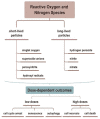The Role of Cold Atmospheric Plasma in Wound Healing Processes in Critically Ill Patients
- PMID: 37240907
- PMCID: PMC10219374
- DOI: 10.3390/jpm13050736
The Role of Cold Atmospheric Plasma in Wound Healing Processes in Critically Ill Patients
Abstract
Critically ill patients are at risk of skin wounds, which reduce their quality of life, complicate their pharmacological regimens, and prolong their hospital stays in intensive care units (ICUs), while also increasing overall mortality and morbidity rates. Cold atmospheric plasma (CAP) has been proposed as a viable option for many biological and medical applications, given its capacity to reduce wound bacterial contamination and promote wound healing. The aim of this narrative review is to describe how CAP works and its operating mechanisms, as well as reporting its possible applications in critical care settings. The success of CAP in the treatment of wounds, in particular, bedsores or pressure sores, presents an innovative path in the prevention of nosocomial infections and an opportunity of reducing the negative implications of these diseases for the NHS. This narrative review of the literature was conducted following the 'Scale for the Assessment of Narrative Review Articles' (SANRA) methodology. Previous literature highlights three biological effects of plasma: inactivation of a wide range of microorganisms, including those that are multi-drug-resistant; increased cell proliferation and angiogenesis with a shorter period of plasma treatment; and apoptosis stimulation with a longer and more intensive treatment. CAP is effective in many areas of the medical field, with no significant adverse effects on healthy cells. However, its use can produce potentially serious side effects and should, therefore, be used under expert supervision and in appropriate doses.
Keywords: cold atmospheric plasma; critical care; infection; wound.
Conflict of interest statement
The authors declare no conflict of interest.
Figures




References
-
- Miller P., Smith I.M., White D.M. Wound Management in the ICU. In: Taylor D.A., Sherry S.P., Sing R.F., editors. Interventional Critical Care. Springer International Publishing; Cham, Switzerland: 2016. pp. 401–409. - DOI
-
- Klausen M., Heydorn A., Ragas P., Lambertsen L., Aaes-Jørgensen A., Molin S., Tolker-Nielsen T. Biofilm Formation by Pseudomonas Aeruginosa Wild Type, Flagella and Type IV Pili Mutants: Roles of Bacterial Motility in the Formation of the Flat P. Aeruginosa Biofilm. Mol. Microbiol. 2003;48:1511–1524. doi: 10.1046/j.1365-2958.2003.03525.x. - DOI - PubMed
Publication types
LinkOut - more resources
Full Text Sources
Miscellaneous

